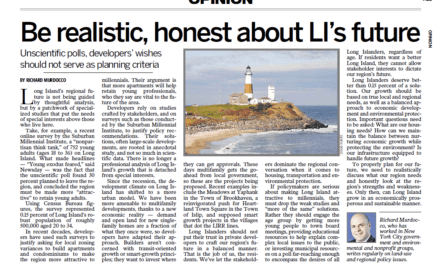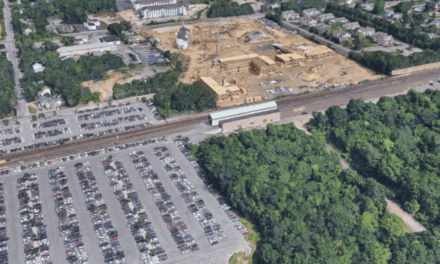The following was published in the special Hamptons edition of The Real Deal Magazine in June 2018. You can read the original here. Interested in supporting The Foggiest Idea’s award-winning reporting and analysis? Click here.
By Richard Murdocco
A handful of officials hold the keys to the area’s land use decisions, making them invaluable to developers.

Part of the site of Pandion Landing, a planned development that got the go-ahead from Shelter Island’s planning board last fall.
From restrictive land use policies to fiercely protective residents, developers on the eastern end of Suffolk County face an uphill battle to not only break ground but secure the zoning that allows them to do so in the first place.
On Long Island, in most instances it’s the townships that have direct control over zoning. Each year, municipalities make the decisions that shape the landscape of a region where developmental pressures compete with farmland charm.
For ambitious builders looking to make their mark, and some profit, on the East End — many parts of which have gone untouched since English and Dutch settlers first carved up the Peconic region in the late 1600s — the trick is getting to know those who hold the keys to the area’s land use.
The Real Deal took a look at six Hamptons policymakers who try to balance growth with preservation.
Jay Schneiderman
Supervisor, Town of Southampton
Before becoming Southampton town supervisor in January 2016, Jay Schneiderman served as a Suffolk County legislator for about 10 years. During his tenure, development pressures have grown, as has the desire to keep the town’s unique character intact.
Keeping the balance requires walking a fine line, Schneiderman told TRD. His administration is focused on grappling with issues beyond the glamour of the Hamptons, including the protection of the area’s surface and groundwater, as well as tackling affordable housing. “When the bottom of the market is $1 million, there are really no opportunities for those who work locally or young people,” he said.
Schneiderman said he sees a lot of teardown projects. And business has been robust. “We’ve seen roughly $1.5 billion in new construction done over the last year,” he said.
Builders are still eager to stake their claim out east, and their geographic parameters are expanding (for more, see TRD’s story on page 36). “We haven’t seen [as much] development west of the Shinnecock Canal as we have further east, but it’s changing,” he said, emphasizing that pressure to grow hasn’t slowed down and that areas like Hamptons Bays and Riverside are “looking for new development.”
But not all areas of Southampton are welcoming. The Hills at Southampton, a 118-unit housing development and golf course planned for 600 wooded acres in East Quogue, has faced a sustained public outcry. The rezoning for the project, by Arizona-based Discovery Land Company, was rejected by the town in December. In April, the developers brought a lawsuit against the town, calling its rejection of the proposal “unlawful and unconstitutional.”
Nonetheless, Discovery is pushing ahead with a strikingly similar proposal that doesn’t require a zone change. “It looks the same, but the usage is different,” Schneiderman said, noting that the builder’s previous proposal focused more heavily on the golf course than residential units.
“I believe the subdivision is as-of-right,” he said. “But we’re fully expecting a legal challenge if it’s approved. This is a largely a seasonal community, and people are still choosing Southampton as the place for their summer homes. It’s important to maintain all the things that make this area a great place to live.”
Peter Van Scoyoc
Supervisor, Town of East Hampton
Peter Van Scoyoc, a descendant of a well-known East End family that dates back to the 1700s, took office as town supervisor in January after a stint as deputy supervisor. He has been on the town board since 2012.
Van Scoyoc, who runs a construction firm and a charter fishing business, has helped shepherd 60 units of affordable housing into the town’s pipeline and is working on creating more, according to Newsday. To Van Scoyoc, small-scale projects such as the Manor House condominiums, a 12-unit affordable project on 3 acres in East Hampton, can serve as a template for future efforts. Conflicts over building affordable housing might ease if relatively small projects are put up in various locations around town, Van Scoyoc told the Sag Harbor Express.
Without more housing options at lower price points, Van Scoyoc is worried that the global appeal of the town will begin to wither. “The problem of the lack of affordable housing has become more and more exacerbated,” he said in the Express interview. “It’s starting to have negative impacts across many sectors of our lives, from not having a large enough base to recruit for our fire departments to not having enough workers for our local businesses, including the town.”
Another focus of his administration has been trying to curb the erosion that threatens the coastline in areas like Montauk. In April, after successive nor’easters tore away chunks of the coastline, the supervisor told the East Hampton Star that the solution is clear: “Ultimately, development needs to move out of the way of the ocean.”
Laura Jens-Smith
Supervisor, Town of Riverhead
Few spots east of the William Floyd Parkway capture the region’s developmental pressures and frustrations like the Town of Riverhead, the gateway to Long Island’s East End. For years, policymakers have attempted to reinject life into both its struggling downtown and Enterprise Park at Calverton (EPCAL), a 2,900-acre site where F-16 Tomcats once roared overhead. The town is currently evaluating a redevelopment plan by Calverton Aviation and Technology for the site, a former naval weapons plant.
Since she was elected in November 2017, Town Supervisor Laura Jens-Smith has routinely expressed her desire to revitalize the municipality’s downtown. A nurse by training, Jens-Smith is taking what she calls a “step-by-step approach to revitalization” in order to attract commercial, retail and restaurants to the former hub. She is also working to establish a form-based zoning code, a set of regulations to help determine the look of future projects, that takes into account the historic character of the area.
Much of the town’s growth in recent years has centered on the development-friendly corridor of County Route 58, which is bordered by shopping centers both large and small. But Jens-Smith feels the town should be less reliant on retail. “With online sales posing a threat, some of Route 58’s big box stores have already shuttered, and more may in the future. So we’re looking far ahead, proactively exploring ideas for alternative uses and tenants, if it comes to that,” she said during her first State of the Town address in April.
In that address, Jens-Smith called EPCAL one of her biggest challenges since taking office. Noting the many hurdles faced, the supervisor has made it a priority to find a partner who can work to restore the runways, create 1 million square feet of commercial and industrial space in the next five years and incubate jobs in both the aviation and technology industries. “We want the entire business community to know Riverhead Town is 100 percent committed to being business-friendly,” she said.
Gary Gerth
Supervisor, Town of Shelter Island
Tucked between the North and South Forks and only accessible by ferry, Shelter Island may be tiny, with a year-round population of just 2,400, but locals say it can provide creative builders with real opportunity.
Town Supervisor Gary Gerth, an ordained pastor who moved to Shelter Island in 1972, was elected in November 2017. In May, Gerth described the island as “an emerald jewel set in the bracelet of turquoise waters” in the New York Times, but he added that “it’s not for everyone.”
As supervisor, Gerth has been outspoken on the island’s need for additional rental housing options and attracting more year-round residents. “It’s a call to maintain or get back to the character of our community, which is one of caring for our brothers and sisters,” he told Newsday shortly after his election.
There are few, if any, development projects in the town, and none that could be considered affordable. But the town’s recently expanded Community Housing Board reportedly expressed its optimism that Gerth’s administration could change that, and Newsday’s editorial board has celebrated the supervisor’s decision to address the island’s lack of year-round rental housing.
New residential development is underway at the former St. Gabriel’s Retreat Center, a pristine 25-acre property on Coecles Harbor. It was sold to financier and part-time resident Richard Hogan in 2015 for $15.1 million. The site was owned by the Passionist Fathers for more than a century up until the sale, but in September 2017 Shelter Island’s planning board approved Pandion Landing, an eight-lot subdivision that would include five homes as well as a host of other community-exclusive amenities, including a boathouse with a dock for residents. Gerth was not in favor. “I was hoping the town would come out to save the place,” Gerth told the Shelter Island Reporter. “I felt like this was a rare parcel and it was such a blessing. Eleven million dollars could have saved it.”
Scott Russell
Supervisor, Town of Southold
Like Southampton, Southold’s focus has been toeing the line between stimulating growth and preserving the rural quality of life that has persisted across the North Fork since the 1600s. “There have been several amendments to our zoning code over the years that incorporate a preservation component in land use applications,” said town supervisor Scott Russell, who was first elected to the post in 2005, after serving as the town’s assessor for 15 years.
The land use controls in Southold are tightly focused and technical. “Southold requires clustered lot design, so if you have 50 acres of land zoned for 2-acre zoning, 30 acres has to remain as open space and the buildable lots have to all be located on the 20 acres left,” Russell explained. That means only 10 homes could be developed on the 50 acres, all built on the remainaing 20 acres. A major goal of the town is to maintain farming activity by selling the development rights of farmland to the town, Russell added.
“Southold has about 10,000 acres of farmland,” Russell said. “The town’s long-standing goal has been to preserve 80 percent of that acreage. For every 2 acres we lose to development, we try to preserve 8 acres of farmland in perpetuity.”
Although Southold doesn’t have anything on the horizon near the scale of Tritec’s Ronkonkoma Hub or Jerry Wolkoff’s Heartland Town Square, the town still gets its share of proposals. There is a 124-unit condo project that is underway in Cutchogue, as well as an affordable apartment proposal in Greenport that would result in 50 affordable apartments on about 11 acres of land. In the past, Russell has been supportive of the creation of projects that diversify the housing options on the North Fork — especially those that are affordable for workers and civil servants.
“What may be considered large in Southold might be modest in other communities,” Russell noted.
George Hubbard Jr.
Mayor, Village of Greenport
The Village of Greenport is a tourist hub during the summer months, with the population nearly doubling thanks to the influx of seasonal visitors. As such, the pressure to accommodate a booming tourism industry — fueled by the vineyards of the North Fork — and the needs of year-round residents has created a balancing act for the village’s policymakers.
Rochester-based Conifer Realty is behind a proposal for Vineyard View, a multifamily project planned for 7 acres of a 17-acre vacant parcel in the village. Conifer is pitching seven two-story buildings, which would contain 50 rental units. Conifer’s plan also includes a 2,649-square-foot community center and 111 parking spaces. The site’s remaining 10 acres would be preserved as open space.
“I think it’s going to fill a need because people need affordable places out here, so overall, it seems like a really good project,” Hubbard told Newsday. “The need for more housing options on the North Fork to accommodate local employees and young people has been discussed among residents and municipal officials for several years.”
Despite the momentum the village has gained with its welcoming attitude toward growth, Hubbard highlighted the limitations it faces in addressing the housing issue. “We have no vacant land for building affordable housing,” Hubbard said at a June 2017 hearing on the topic.













